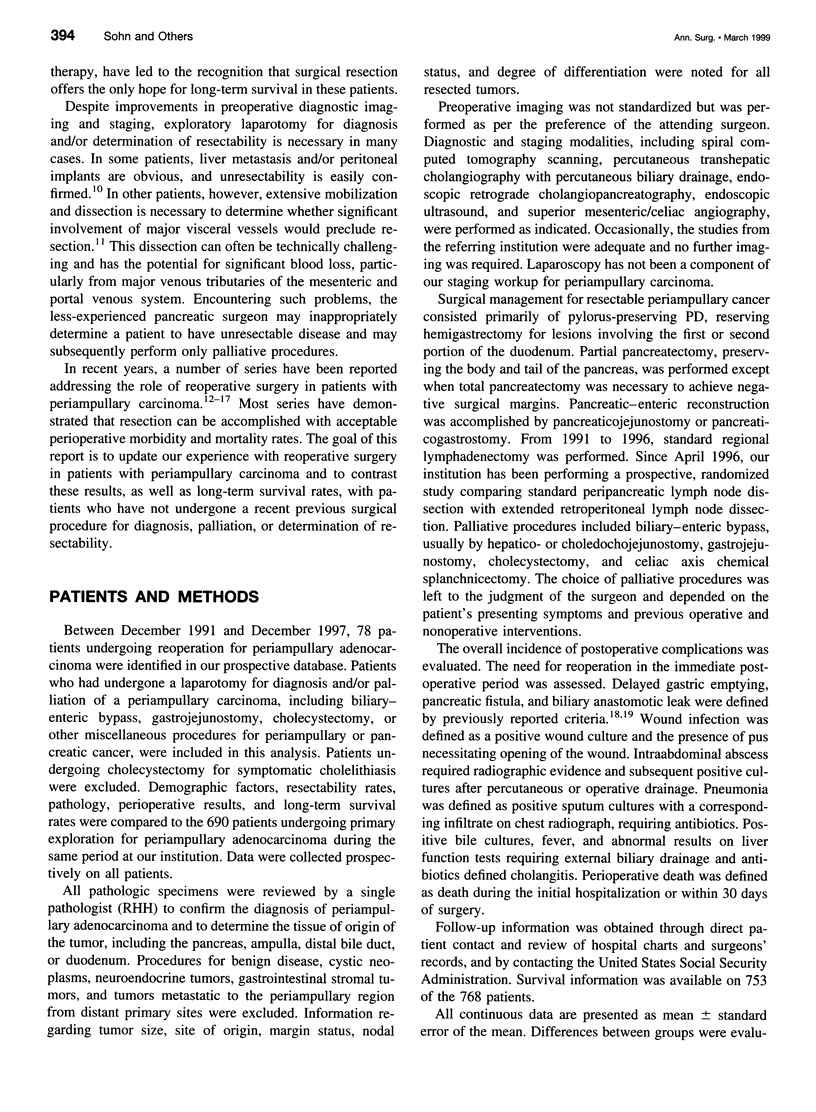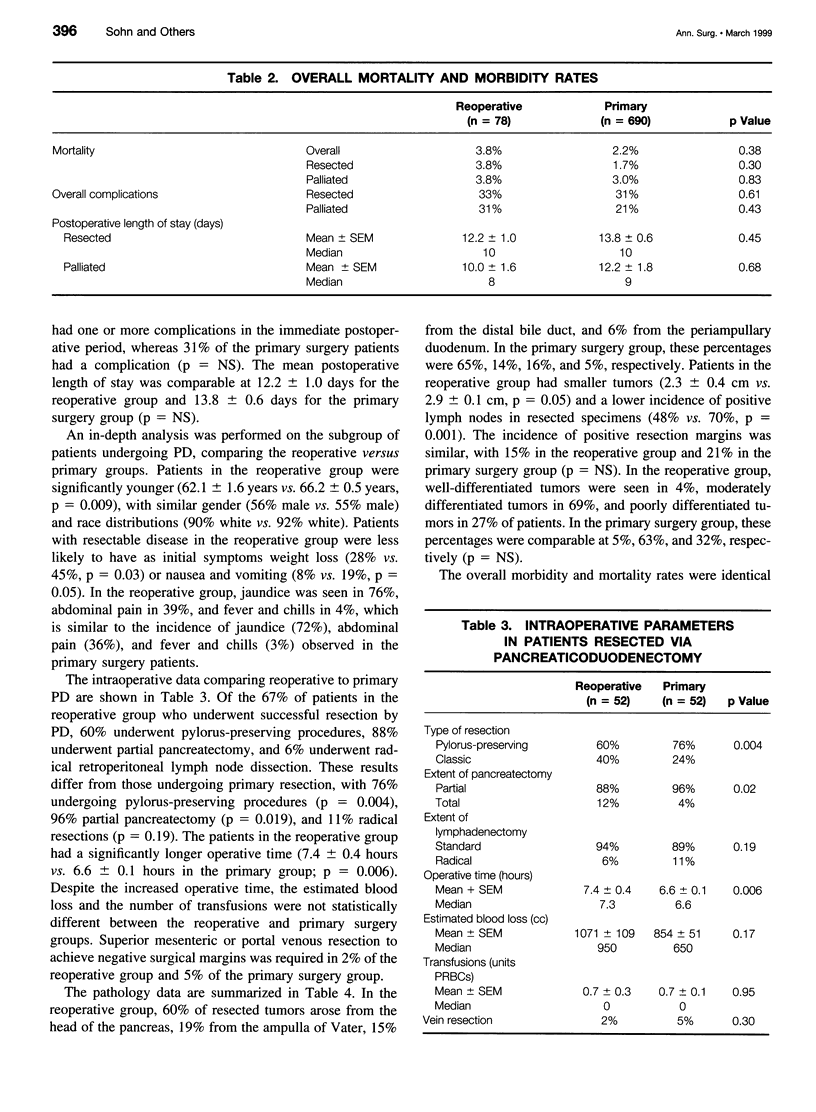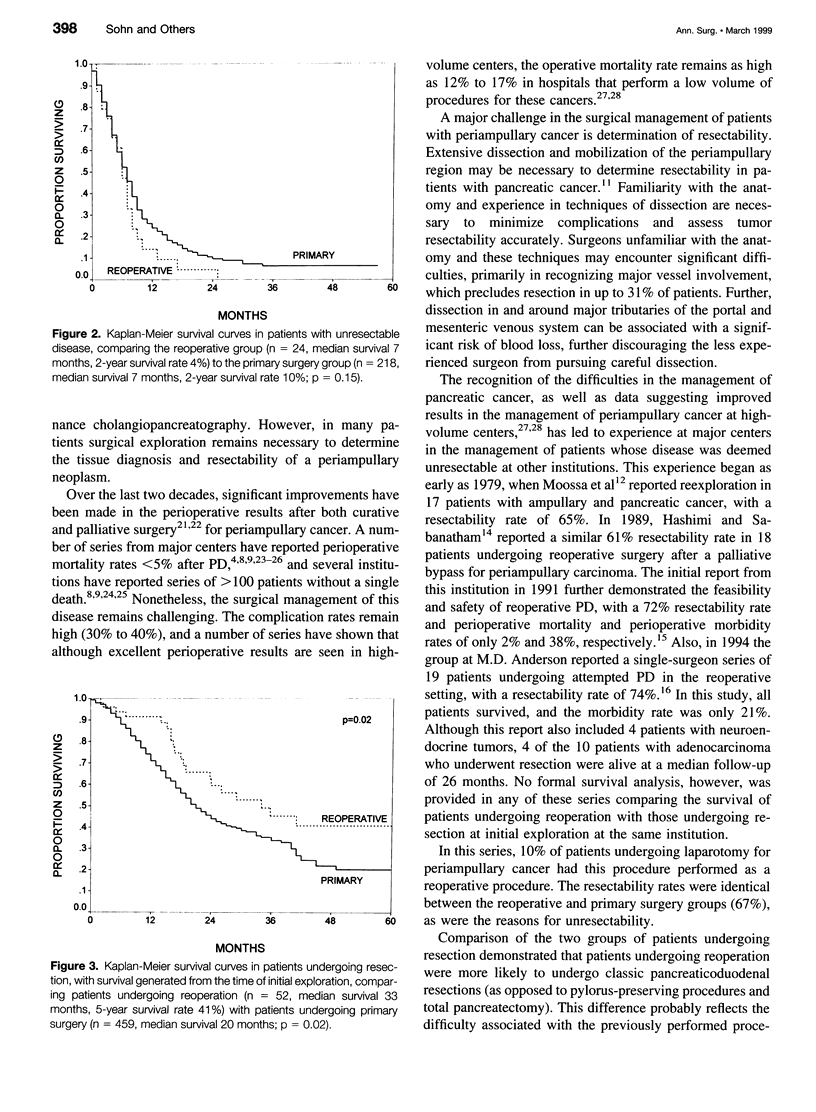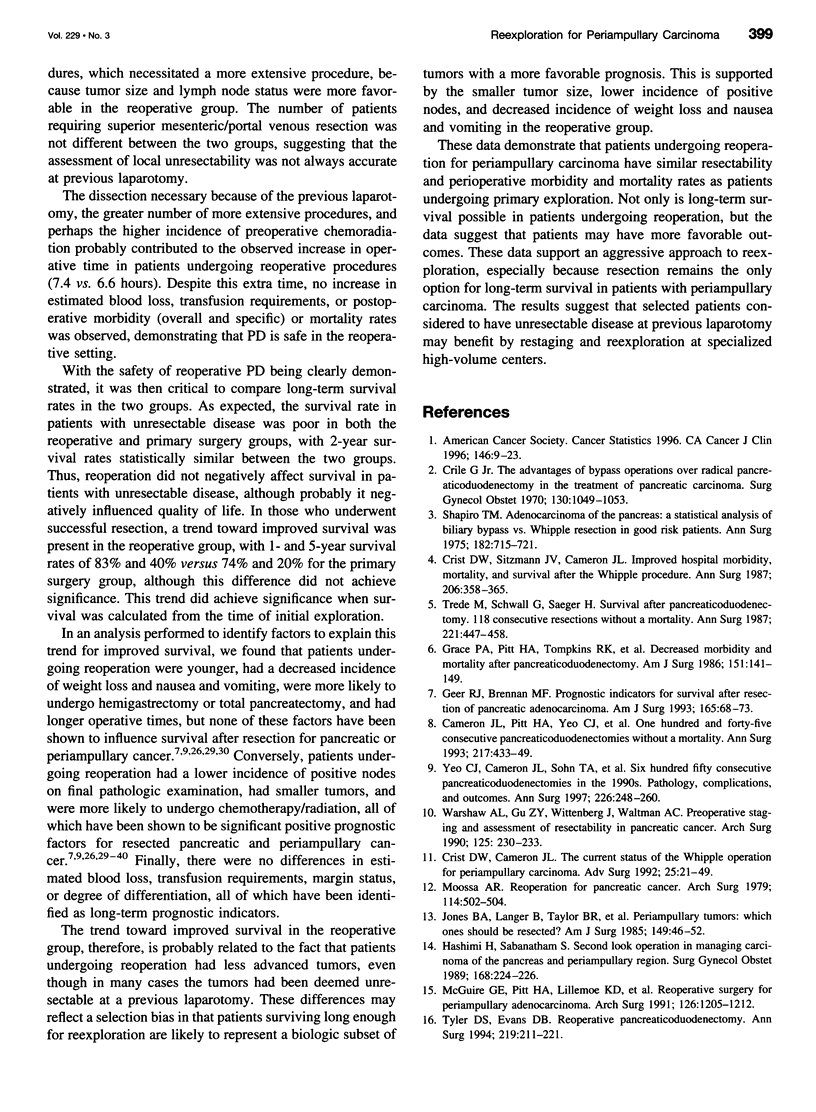Abstract
OBJECTIVE: This single-institution experience retrospectively reviews the outcomes of patients undergoing reexploration for periampullary carcinoma at a high-volume center. SUMMARY BACKGROUND DATA: Many patients are referred to tertiary centers with periampullary carcinoma after their tumors were deemed unresectable at previous laparotomy. In carefully selected patients, tumor resection is often possible; however, the perioperative results and long-term outcome have not been well defined. METHODS: From November 1991 through December 1997, 78 patients who underwent previous exploratory laparotomy and/or palliative surgery for suspected periampullary carcinoma underwent reexploration. The operative outcome, resectability rate, pathology, and long-term survival rate were compared with 690 concurrent patients who had not undergone previous exploratory surgery. RESULTS: Fifty-two of the 78 patients (67%) undergoing reexploration underwent successful resection by pancreaticoduodenectomy; the remaining 26 patients (34%) were deemed to have unresectable disease. Compared with the 690 patients who had not undergone recent related surgery, the patients in the reoperative group were similar with respect to gender, race, and resectability rate but were significantly younger. The distribution of periampullary cancers by site in the reoperative group undergoing pancreaticoduodenectomy (n = 52) was 60%, 19%, 15%, and 6% for pancreatic, ampullary, distal bile duct, and duodenal tumors, respectively. These figures were similar to the 65%, 14%, 16% and 5% for resectable periampullary cancers found in the primary surgery group (n = 460). Intraoperative blood loss and transfusion requirements did not differ between the two groups. However, the mean operative time was 7.4 hours in the reoperative group, significantly longer than in the control group. On pathologic examination, reoperative patients had smaller tumors, and the percentage of patients with positive lymph nodes in the resection specimen was significantly less. The incidence of positive margins was similar between the two groups. Postoperative lengths of stay, complication rates, and perioperative mortality rates were not higher in reoperative patients. The long-term survival rate was similar between the two resected groups, with a median survival of 24 months in the reoperative group and 20 months in those without previous exploration. CONCLUSIONS: These data demonstrate that patients undergoing reoperation for periampullary carcinoma have similar resectability, perioperative morbidity and mortality, and long-term survival rates as patients undergoing initial exploration. The results suggest that selected patients considered to have unresectable disease at previous surgery should undergo restaging and reexploration at specialized high-volume centers.
Full text
PDF







Selected References
These references are in PubMed. This may not be the complete list of references from this article.
- Crile G., Jr The advantages of bypass operations over radical pancreatoduodenectomy in the treatment of pancreatic carcinoma. Surg Gynecol Obstet. 1970 Jun;130(6):1049–1053. [PubMed] [Google Scholar]
- Crist D. W., Cameron J. L. The current status of the Whipple operation for periampullary carcinoma. Adv Surg. 1992;25:21–49. [PubMed] [Google Scholar]
- Crist D. W., Sitzmann J. V., Cameron J. L. Improved hospital morbidity, mortality, and survival after the Whipple procedure. Ann Surg. 1987 Sep;206(3):358–365. doi: 10.1097/00000658-198709000-00014. [DOI] [PMC free article] [PubMed] [Google Scholar]
- Fernández-del Castillo C., Rattner D. W., Warshaw A. L. Standards for pancreatic resection in the 1990s. Arch Surg. 1995 Mar;130(3):295–300. doi: 10.1001/archsurg.1995.01430030065013. [DOI] [PubMed] [Google Scholar]
- Geer R. J., Brennan M. F. Prognostic indicators for survival after resection of pancreatic adenocarcinoma. Am J Surg. 1993 Jan;165(1):68–73. doi: 10.1016/s0002-9610(05)80406-4. [DOI] [PubMed] [Google Scholar]
- Gordon T. A., Burleyson G. P., Tielsch J. M., Cameron J. L. The effects of regionalization on cost and outcome for one general high-risk surgical procedure. Ann Surg. 1995 Jan;221(1):43–49. doi: 10.1097/00000658-199501000-00005. [DOI] [PMC free article] [PubMed] [Google Scholar]
- Grace P. A., Pitt H. A., Longmire W. P. Pylorus preserving pancreatoduodenectomy: an overview. Br J Surg. 1990 Sep;77(9):968–974. doi: 10.1002/bjs.1800770906. [DOI] [PubMed] [Google Scholar]
- Grace P. A., Pitt H. A., Tompkins R. K., DenBesten L., Longmire W. P., Jr Decreased morbidity and mortality after pancreatoduodenectomy. Am J Surg. 1986 Jan;151(1):141–149. doi: 10.1016/0002-9610(86)90024-3. [DOI] [PubMed] [Google Scholar]
- Hashimi H., Sabanathan S. Second look operation in managing carcinoma of the pancreas and periampullary region. Surg Gynecol Obstet. 1989 Mar;168(3):224–226. [PubMed] [Google Scholar]
- Jones B. A., Langer B., Taylor B. R., Girotti M. Periampullary tumors: which ones should be resected? Am J Surg. 1985 Jan;149(1):46–52. doi: 10.1016/s0002-9610(85)80008-8. [DOI] [PubMed] [Google Scholar]
- Kalser M. H., Ellenberg S. S. Pancreatic cancer. Adjuvant combined radiation and chemotherapy following curative resection. Arch Surg. 1985 Aug;120(8):899–903. doi: 10.1001/archsurg.1985.01390320023003. [DOI] [PubMed] [Google Scholar]
- Lieberman M. D., Kilburn H., Lindsey M., Brennan M. F. Relation of perioperative deaths to hospital volume among patients undergoing pancreatic resection for malignancy. Ann Surg. 1995 Nov;222(5):638–645. doi: 10.1097/00000658-199511000-00006. [DOI] [PMC free article] [PubMed] [Google Scholar]
- Lillemoe K. D., Sauter P. K., Pitt H. A., Yeo C. J., Cameron J. L. Current status of surgical palliation of periampullary carcinoma. Surg Gynecol Obstet. 1993 Jan;176(1):1–10. [PubMed] [Google Scholar]
- McGuire G. E., Pitt H. A., Lillemoe K. D., Niederhuber J. E., Yeo C. J., Cameron J. L. Reoperative surgery for periampullary adenocarcinoma. Arch Surg. 1991 Oct;126(10):1205–1212. doi: 10.1001/archsurg.1991.01410340043007. [DOI] [PubMed] [Google Scholar]
- Miedema B. W., Sarr M. G., van Heerden J. A., Nagorney D. M., McIlrath D. C., Ilstrup D. Complications following pancreaticoduodenectomy. Current management. Arch Surg. 1992 Aug;127(8):945–950. doi: 10.1001/archsurg.1992.01420080079012. [DOI] [PubMed] [Google Scholar]
- Monson J. R., Donohue J. H., McEntee G. P., McIlrath D. C., van Heerden J. A., Shorter R. G., Nagorney D. M., Ilstrup D. M. Radical resection for carcinoma of the ampulla of Vater. Arch Surg. 1991 Mar;126(3):353–357. doi: 10.1001/archsurg.1991.01410270099016. [DOI] [PubMed] [Google Scholar]
- Moossa A. R. Reoperation for pancreatic cancer. Arch Surg. 1979 Apr;114(4):502–504. doi: 10.1001/archsurg.1979.01370280156025. [DOI] [PubMed] [Google Scholar]
- Nakeeb A., Pitt H. A., Sohn T. A., Coleman J., Abrams R. A., Piantadosi S., Hruban R. H., Lillemoe K. D., Yeo C. J., Cameron J. L. Cholangiocarcinoma. A spectrum of intrahepatic, perihilar, and distal tumors. Ann Surg. 1996 Oct;224(4):463–475. doi: 10.1097/00000658-199610000-00005. [DOI] [PMC free article] [PubMed] [Google Scholar]
- Robinson E. K., Lee J. E., Lowy A. M., Fenoglio C. J., Pisters P. W., Evans D. B. Reoperative pancreaticoduodenectomy for periampullary carcinoma. Am J Surg. 1996 Nov;172(5):432–438. doi: 10.1016/S0002-9610(96)00218-8. [DOI] [PubMed] [Google Scholar]
- Scott-Coombes D. M., Williamson R. C. Surgical treatment of primary duodenal carcinoma: a personal series. Br J Surg. 1994 Oct;81(10):1472–1474. doi: 10.1002/bjs.1800811023. [DOI] [PubMed] [Google Scholar]
- Shapiro T. M. Adenocarcinoma of the pancreas: a statistical analysis of biliary bypass vs Whipple resection in good risk patients. Ann Surg. 1975 Dec;182(6):715–721. doi: 10.1097/00000658-197512000-00010. [DOI] [PMC free article] [PubMed] [Google Scholar]
- Sohn T. A., Lillemoe K. D., Cameron J. L., Pitt H. A., Kaufman H. S., Hruban R. H., Yeo C. J. Adenocarcinoma of the duodenum: factors influencing long-term survival. J Gastrointest Surg. 1998 Jan-Feb;2(1):79–87. doi: 10.1016/s1091-255x(98)80107-8. [DOI] [PubMed] [Google Scholar]
- Talamini M. A., Moesinger R. C., Pitt H. A., Sohn T. A., Hruban R. H., Lillemoe K. D., Yeo C. J., Cameron J. L. Adenocarcinoma of the ampulla of Vater. A 28-year experience. Ann Surg. 1997 May;225(5):590–600. doi: 10.1097/00000658-199705000-00015. [DOI] [PMC free article] [PubMed] [Google Scholar]
- Tompkins R. K., Thomas D., Wile A., Longmire W. P., Jr Prognostic factors in bile duct carcinoma: analysis of 96 cases. Ann Surg. 1981 Oct;194(4):447–457. doi: 10.1097/00000658-198110000-00008. [DOI] [PMC free article] [PubMed] [Google Scholar]
- Trede M., Schwall G., Saeger H. D. Survival after pancreatoduodenectomy. 118 consecutive resections without an operative mortality. Ann Surg. 1990 Apr;211(4):447–458. doi: 10.1097/00000658-199004000-00011. [DOI] [PMC free article] [PubMed] [Google Scholar]
- Tyler D. S., Evans D. B. Reoperative pancreaticoduodenectomy. Ann Surg. 1994 Feb;219(2):211–221. doi: 10.1097/00000658-199402000-00014. [DOI] [PMC free article] [PubMed] [Google Scholar]
- Warshaw A. L., Gu Z. Y., Wittenberg J., Waltman A. C. Preoperative staging and assessment of resectability of pancreatic cancer. Arch Surg. 1990 Feb;125(2):230–233. doi: 10.1001/archsurg.1990.01410140108018. [DOI] [PubMed] [Google Scholar]
- Watanapa P., Williamson R. C. Surgical palliation for pancreatic cancer: developments during the past two decades. Br J Surg. 1992 Jan;79(1):8–20. doi: 10.1002/bjs.1800790105. [DOI] [PubMed] [Google Scholar]
- Wei T. C., Yu S. C., Lee P. H., Hsu S. C. Carcinoma of the ampulla of Vater: long-term survival after surgical treatment. J Formos Med Assoc. 1993 Jul;92(7):632–637. [PubMed] [Google Scholar]
- Yeo C. J., Abrams R. A., Grochow L. B., Sohn T. A., Ord S. E., Hruban R. H., Zahurak M. L., Dooley W. C., Coleman J., Sauter P. K. Pancreaticoduodenectomy for pancreatic adenocarcinoma: postoperative adjuvant chemoradiation improves survival. A prospective, single-institution experience. Ann Surg. 1997 May;225(5):621–636. doi: 10.1097/00000658-199705000-00018. [DOI] [PMC free article] [PubMed] [Google Scholar]
- Yeo C. J., Barry M. K., Sauter P. K., Sostre S., Lillemoe K. D., Pitt H. A., Cameron J. L. Erythromycin accelerates gastric emptying after pancreaticoduodenectomy. A prospective, randomized, placebo-controlled trial. Ann Surg. 1993 Sep;218(3):229–238. doi: 10.1097/00000658-199309000-00002. [DOI] [PMC free article] [PubMed] [Google Scholar]
- Yeo C. J., Cameron J. L., Lillemoe K. D., Sitzmann J. V., Hruban R. H., Goodman S. N., Dooley W. C., Coleman J., Pitt H. A. Pancreaticoduodenectomy for cancer of the head of the pancreas. 201 patients. Ann Surg. 1995 Jun;221(6):721–733. doi: 10.1097/00000658-199506000-00011. [DOI] [PMC free article] [PubMed] [Google Scholar]
- Yeo C. J., Cameron J. L., Maher M. M., Sauter P. K., Zahurak M. L., Talamini M. A., Lillemoe K. D., Pitt H. A. A prospective randomized trial of pancreaticogastrostomy versus pancreaticojejunostomy after pancreaticoduodenectomy. Ann Surg. 1995 Oct;222(4):580–592. doi: 10.1097/00000658-199510000-00014. [DOI] [PMC free article] [PubMed] [Google Scholar]
- Yeo C. J., Cameron J. L., Sohn T. A., Lillemoe K. D., Pitt H. A., Talamini M. A., Hruban R. H., Ord S. E., Sauter P. K., Coleman J. Six hundred fifty consecutive pancreaticoduodenectomies in the 1990s: pathology, complications, and outcomes. Ann Surg. 1997 Sep;226(3):248–260. doi: 10.1097/00000658-199709000-00004. [DOI] [PMC free article] [PubMed] [Google Scholar]
- Yeo C. J., Sohn T. A., Cameron J. L., Hruban R. H., Lillemoe K. D., Pitt H. A. Periampullary adenocarcinoma: analysis of 5-year survivors. Ann Surg. 1998 Jun;227(6):821–831. doi: 10.1097/00000658-199806000-00005. [DOI] [PMC free article] [PubMed] [Google Scholar]


